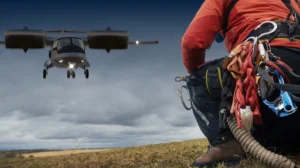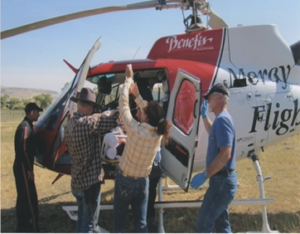Imagine an emergency response aircraft covering 700 miles at speeds exceeding 300 knots. It can rapidly reach remote or congested areas and land in tight spaces, vertically, without disrupting the surrounding environment. This isn’t a distant vision—it’s the future of emergency response, set to take flight within the next 3-5 years.
 Powered by advanced turbine engines, these long-range VTOL (vertical takeoff and landing) aircraft are on the verge of reshaping critical response operations across the United States and beyond, bringing unprecedented speed and reach to emergency services. For example, the New York City Fire Department has tested a prototype VTOL aircraft that can reach a high-rise fire in as little as 10 minutes, compared to the 20 minutes it takes for a traditional helicopter.
Powered by advanced turbine engines, these long-range VTOL (vertical takeoff and landing) aircraft are on the verge of reshaping critical response operations across the United States and beyond, bringing unprecedented speed and reach to emergency services. For example, the New York City Fire Department has tested a prototype VTOL aircraft that can reach a high-rise fire in as little as 10 minutes, compared to the 20 minutes it takes for a traditional helicopter.
Why We Need Long-Range VTOLs in Emergency Response
Due to its vast geography, diverse terrain, and densely populated urban centers, the United States faces unique challenges in emergency response. FEMA says a major disaster has hit 92% of U.S. counties in the last decade.
As a result of natural disasters like hurricanes, wildfires, and floods, millions of people have been affected. Life and death can depend on response times, especially in rural and hard-to-reach areas. A delay of just one minute in emergency medical treatment can reduce heart attack survival rates by 10%. By cutting these critical minutes, higher-speed, long-range VTOLs can reach emergency sites faster than any ground-based or traditional air response.
Setting New Standards: Speed, Range, and Precision
Long-range VTOLs combine the best attributes of helicopters and fixed-wing aircrafts. As such, VTOLs will redefine emergency response. Unlike eVTOL (electric VTOL) models garnering all the press’ attention, turbine-powered VTOL can cover vast distances in one flight thanks to their endurance and speed. A VTOL aircraft can quickly travel from an urban command center to remote disaster zones, rural hospitals, or crowded metropolitan areas, even with heavy traffic. As a result, life-saving resources and personnel can be transported directly to the incident scene without the delays and risks associated if forced to use multiple modes of transport for the same mission
With this superior speed and range, a VTOL could transport a trauma specialist from a major city to a rural hospital 600 miles away in two hours. This is a crucial advantage in situations where every minute counts. In urban emergencies, where congestion often slows ground response, VTOLs can bypass traffic altogether, reaching locations helicopters cannot go due to distance and time constraints.
Transformative Impact on Disaster and Medical Response
The projected impact of long-range VTOLs on U.S. emergency services is substantial.
 Medical Response: The U.S. suffers an average of 350,000 out-of-hospital cardiac arrests each year. For many, survival depends on swift medical intervention. Long-range VTOLs could deploy specialized emergency medical teams across hundreds of miles, drastically reducing response times in underserved rural communities, where access to advanced emergency care can be limited.
Medical Response: The U.S. suffers an average of 350,000 out-of-hospital cardiac arrests each year. For many, survival depends on swift medical intervention. Long-range VTOLs could deploy specialized emergency medical teams across hundreds of miles, drastically reducing response times in underserved rural communities, where access to advanced emergency care can be limited.- Disaster Relief: Natural disasters in the U.S. have affected over 250 million people in the past decade, with total economic damages exceeding $1.5 trillion. VTOLs could be deployed immediately following events like hurricanes or wildfires, delivering medical supplies, assessing damage, and providing on-the-ground support far faster than traditional methods.
- Search and Rescue: The U.S. conducts thousands of search and rescue missions annually in remote regions and national parks. Long-range VTOLs offer an unparalleled advantage, taking off and landing vertically precisely where traditional fixed-wing aircraft cannot reach, potentially saving countless lives during time-sensitive rescues.
Critical Infrastructure and Integration Needs
For the U.S. to fully capitalize on long-range VTOL potential, several components must be in place:
- Additional Landing Sites: While these VTOLs can operate in confined spaces, strategic placement of developed landing sites in remote and rural areas, as well as in densely populated urban locations, will optimize response times and expand VTOL accessibility.
- Regulatory Frameworks: Integrating turbine-powered VTOLs into national airspace requires streamlined regulatory processes to allow rapid deployment during emergencies, especially in airspace shared with commercial traffic. The recent FAA Special Federal Aviation Regulation (SFAR) on powered-lift aircraft has made significant progress, establishing foundational operational guidelines for safe and efficient integration of VTOLs into controlled airspace.
This regulatory advancement paves the way for expedited deployment of fast, long-range VTOLs in emergency response, ensuring they can operate alongside commercial air traffic with minimal delays and enhanced safety compliance. - Interagency Coordination: For seamless response, agencies like FEMA, the National Guard, and local health networks must integrate VTOLs into their operations, ensuring that aircraft are on standby and ready for deployment when disasters strike. The impact of long-range VTOLs on U.S. emergency services is significant. VTOLs can rapidly deploy specialized medical teams to rural areas in medical emergencies, such as out-of-hospital cardiac arrest. In disaster relief, these aircraft can immediately deliver supplies and assess damage following natural disasters, which are responsible for more than $1.5 trillion in damages.
VTOLs provide an advantage for search and rescue missions in remote regions by accessing areas that fixed-wing aircraft cannot. Additional developed landing sites, updated regulatory frameworks, and interagency coordination are essential to leverage VTOL capabilities fully. The recent FAA release of the powered lift SFAR marks a significant step forward in integrating these aircraft into national airspace. This will facilitate rapid deployment in emergencies.
Pioneering a New Era in Emergency Response
Introducing turbine-powered, long-range VTOLs into U.S. emergency services will represent a profound shift in capability, enabling responders to meet crises faster, farther, and with greater precision. By investing in these technologies and preparing infrastructure, the U.S. will redefine its response to natural disasters, medical emergencies, and search and rescue operations.
This segment of the VTOL market is more than just a technical innovation—it’s a paradigm shift for emergency services. Long-range, high-speed VTOLs will become essential tools in our response arsenal. These aircraft offer a future where geography no longer limits emergency response. They offer time-sensitive medical care accessible across distances, and critical interventions reach those in need faster than ever.
The future of emergency response is airborne, powerful, and unbound by land and air limits. As long-range VTOLs come online, they will save lives and set new standards for resilience and preparedness nationwide.
Author: John Ramstead, CPLC, ACC
